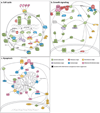The Amphimedon queenslandica genome and the evolution of animal complexity
- PMID: 20686567
- PMCID: PMC3130542
- DOI: 10.1038/nature09201
The Amphimedon queenslandica genome and the evolution of animal complexity
Abstract
Sponges are an ancient group of animals that diverged from other metazoans over 600 million years ago. Here we present the draft genome sequence of Amphimedon queenslandica, a demosponge from the Great Barrier Reef, and show that it is remarkably similar to other animal genomes in content, structure and organization. Comparative analysis enabled by the sequencing of the sponge genome reveals genomic events linked to the origin and early evolution of animals, including the appearance, expansion and diversification of pan-metazoan transcription factor, signalling pathway and structural genes. This diverse 'toolkit' of genes correlates with critical aspects of all metazoan body plans, and comprises cell cycle control and growth, development, somatic- and germ-cell specification, cell adhesion, innate immunity and allorecognition. Notably, many of the genes associated with the emergence of animals are also implicated in cancer, which arises from defects in basic processes associated with metazoan multicellularity.
Figures




References
-
- Hanahan D, Weinberg RA. The hallmarks of cancer. Cell. 2000;100:57–70. - PubMed
-
- Muller WE, Muller IM. Origin of the metazoan immune system: identification of the molecules and their functions in sponges. Integr. Comp. Biol. 2003;43:281–292. - PubMed
-
- Muller WE, et al. Bauplan of Urmetazoa: basis for genetic complexity of metazoa. Int. Rev. Cytol. 2004;235:53–92. - PubMed
-
- Grant RE. Animal Kingdom. In: Todd RB, editor. The Cyclopaedia of Anatomy and Physiology. Vol. 1. Sherwood-Gilbert-Piper; 1836.
-
- Sollas WJ. Report on the Scientific Results of the Voyage of H.M.S. Challenger. Vol. 25 1888. Report on the Tetractinellida.
Publication types
MeSH terms
Substances
Grants and funding
LinkOut - more resources
Full Text Sources
Other Literature Sources
Molecular Biology Databases

